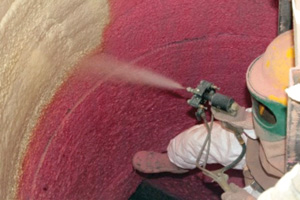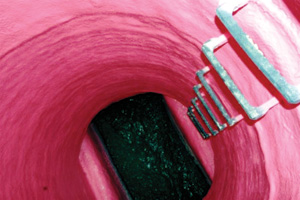Addressing Denver’s Manholes
September 1, 2008
 The Metro Wastewater Reclamation District (MWRD) located in Denver, recently completed a large manhole rehabilitation project that netted a total cost savings of in excess of $500,000, with an over 50 percent unit cost reduction compared to previous manhole projects, as well as more than doubling the number of structures they were able to address at one time.
The Metro Wastewater Reclamation District (MWRD) located in Denver, recently completed a large manhole rehabilitation project that netted a total cost savings of in excess of $500,000, with an over 50 percent unit cost reduction compared to previous manhole projects, as well as more than doubling the number of structures they were able to address at one time.The project, designed in-house and embarked on by the MWRD, resulted in 142 manholes being rehabilitated, covering 25,549 sq ft and 1,625 vertical ft. Beyond the number of manholes taken care of, MWRD is proud that its five-step manhole rehabilitation product approval program that it developed in-house in 2004 has proven to be a success with this large project.
“We are starting to see the fruits of the labor for this whole process we began at the end of 2004,” says Jeff Maier P.E., MWRD Engineer III and district project manager and lead design engineer for the 2007 manhole rehabilitation project. “It’s definitely a testament that we developed a quality screening process for these different manhole rehab products. It’s definitely a success.”
The MWRD is the wastewater treatment authority for most of metro Denver. It was formed by the Colorado state legislature in 1961 to provide wastewater transmission and treatment services to member municipalities and special connectors in compliance with federal, state and local laws. The district provides wholesale wastewater transmission and treatment service to 55 local governments in the Denver metropolitan area. These local governments provide retail wastewater services to approximately 1.5 million people in a 380 sq mile area. MWRD collects about 130 million gals of wastewater per day from neighborhood sewer lines and delivers it through approximately 250 miles of interceptor sewers to the MWRD — Robert W. Hite Central Treatment Plant in northeast Denver.
There are approximately 4,500 manholes in MWRD’s trunk line sewer system. Prior to initiating the manhole rehabilitation program, past projects resulted in around 20 to 60 manholes being rehabilitated, mostly in a less efficient and more expensive manner — something Maier says MWRD has worked hard to change. MWRD wanted to develop projects that address manholes on a much larger scale.
The manholes for this particular project were mostly located in the City and County of Denver but a few were in the surrounding suburbs. The manholes were of varying ages, with the oldest being more than 50 years old. The majority of them were constructed of reinforced concrete and pre-cast barrel sections; some of the older structures were made of brick.
The primary problem with the structures was that they were affected by corrosion due to exposure to hydrogen sulfide (H2S), resulting in a loss of integrity of the manholes, as well as other problems.
“We were starting to lose some structural integrity in the manholes,” Maier says. “Some of the manholes were losing a couple inches of concrete and concrete was sloughing off and becoming soft due to the interaction of the H2S gas and biogenic sulfide corrosion.”
To evaluate the manholes in its system, MWRD’s maintenance crews used periodic inspections, both internally and from the surface to rate them, targeting those that appeared to have severe corrosion, root infiltration and/or water infiltration. Using that information, MWRD engineers reassessed the problematic manholes and then put together a hit list of those manholes deemed to be in dire need of rehabilitation.
MWRD Selection Process
MWRD is not a novice at manhole rehabilitation but management believed it needed to improve on its product selection and contractor bidding to get the best results. In 2004, MWRD decided to self-evaluate its previous manhole rehabilitation program. In its recent past, the district had mixed success in terms of products used and contractors that applied the product. What came out of that introspection was a stringent five-step approval process that Maier says is unlike any other municipality.
“What we needed to do was to find effective products and good contractors and develop a method in order to weed through the typical sales pitches,” Maier says. “We took it upon ourselves to develop a five-step approval process program. It is a unique, ongoing program that assesses rehabilitation products, coatings and linings and their true ability to withstand long-term, real world corrosive sewer conditions.”
The five-step approval program includes: product/contractor information gathering; official vendor presentation; site visit to another municipality to see how the product has worked there; local demonstration installation; and a report on its findings.
“The existing tests that were out there, we just felt that they didn’t provide an accurate assessment of what’s really going on in real life severe wastewater environments,” Maier says. “On the municipal side of things, it’s pretty unique what we’ve done. We’ve basically put this program together to seek out both the products that work and the contractors who are quality applicators.”
He notes that the site visit is very important. MWRD likes to visit municipalities in the southern tier states where Maier says you can find the most severe conditions that manholes face, such as infiltration, high levels of hydrogen sulfide and significant biogenic sulfide corrosion. “Typically we have gone to locations in Florida, Georgia and Arizona so the product manufacturer can show us their oldest manhole rehabilitations with the most severe conditions and we can see firsthand how these manholes have held up over time,” he says. “If [the product’s] able to perform well there in those conditions, it’s going to perform well in the Denver area where we typically have less infiltration problems and lower hydrogen sulfide levels.”
To date, there are five products that have received MWRD’s approval for use, including SpectraShield, which was used on this particular project. SpectraShield participated in the process after SpectraShield president Sims Rhyne and Maier met at an industry trade show in early 2006; a few weeks later, Rhyne was giving his vendor presentation to the MWRD and was later approved through the process. Concrete Conservation Inc. (CCI), a SpectraShield licensee that operates in Florida and the Mountain West, submitted the winning bid for the project.
“It’s probably one of the most extensive [processes] that I’ve been through,” Rhyne says. “[MWRD] really does their homework, including site visits to inspect older installations. This was a great project and it went really well.”
 CCI began work on the project in October 2007, tackling an average of three manholes a day using the SpectraShield coating system. “With our process, we can line 7-ft deep manholes in less than one hour,” Rhyne says. “For this project, the manholes were much larger than typical manholes. The average depth of the manholes was 12 to 13 ft. We were able to line three manholes a day.”
CCI began work on the project in October 2007, tackling an average of three manholes a day using the SpectraShield coating system. “With our process, we can line 7-ft deep manholes in less than one hour,” Rhyne says. “For this project, the manholes were much larger than typical manholes. The average depth of the manholes was 12 to 13 ft. We were able to line three manholes a day.”Once the work was completed, MWRD used high-voltage testing to sweep over the manholes, as well as visual testing, inspecting the contractor’s work. Maier says MWRD is more than pleased with the outcome — in fact, the 142 manholes exceeded the number originally planned for the project by 22. “We started tacking on extra manholes because [CCI] did such a great job and were ahead of schedule.”
Maier says the success of the project means MWRD’s approval program is working. “[SpectraShield] was approved by the program and they came in and were able to get a large number of manholes done in a short amount of time. We really started to make some headway in improving the infrastructure of our manhole system.”
Maier says that MWRD is proactive in its approach to manhole rehabilitation, crafting in-house designed projects that specifically address manhole conditions and not just lumping them into pipeline rehab projects as many municipalities do. “I consider us a leader on the manhole front,” Maier says. “With many municipalities and those engineers and consultants that are given a pipeline rehab project, they tend to tack on the manholes as an afterthought. The unfortunate part of that approach is that the manholes are probably just as important as the pipe in terms of collection system integrity. We really have taken a proactive approach with this approval process in addressing the state of our manholes.”
Maier says the success of this project will likely propel the district into doing more large scale manhole rehab projects on an annual basis. “Until all of our manholes are taken care of,” he says.
Sharon M. Bueno is managing editor of Trenchless Technology.
MWRD’s Five-Step Approval Program1. Research/Gather Information: Pour over the different productliterature, read reports on products, attend industry trade shows andforums and get a clear idea of what products and rehabilitation methodsare out there. 2. Vendor Presentation: Arrange for a vendor presentation at thedistrict (approx. one hour long) and hit them with some pretty hardquestions to get the most information. Ask for references. 3. Site Visit: Travel to a municipality that has used the product totalk to them about the product and how it has worked. Inspect the workthat was done there. 4. Free Installation Demonstration: Use local contractors todemonstrate the product to see exactly what steps are taken forpreparation, cleaning and installation. 5. Approval Report: Assemble the findings and determine whether theproduct is the correct choice for use on future MWRD projects. Ifapproved, the report recommends use of the product along with findingsthroughout the approval process. Note: For more detailed program information, contact MWRD at information@mwrd.dst.co.us |
